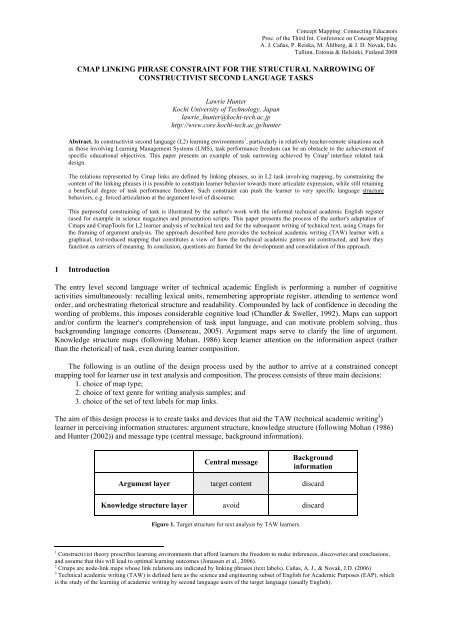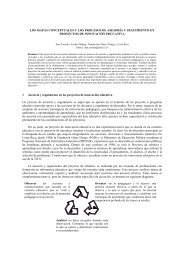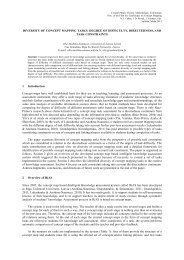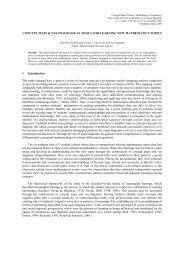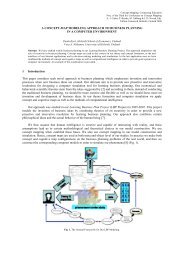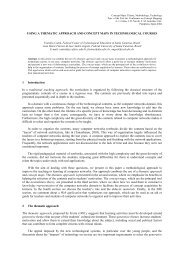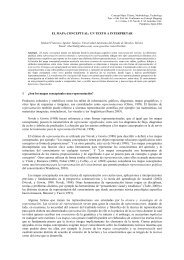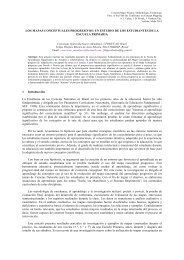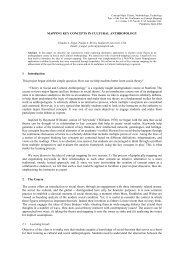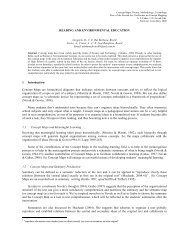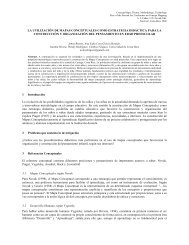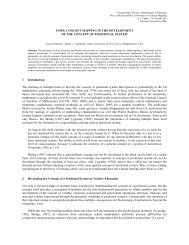CMAP LINKING PHRASE CONSTRAINT FOR THE STRUCTURAL ...
CMAP LINKING PHRASE CONSTRAINT FOR THE STRUCTURAL ...
CMAP LINKING PHRASE CONSTRAINT FOR THE STRUCTURAL ...
Create successful ePaper yourself
Turn your PDF publications into a flip-book with our unique Google optimized e-Paper software.
Concept Mapping: Connecting EducatorsProc. of the Third Int. Conference on Concept MappingA. J. Cañas, P. Reiska, M. Åhlberg, & J. D. Novak, Eds.Tallinn, Estonia & Helsinki, Finland 2008<strong>CMAP</strong> <strong>LINKING</strong> <strong>PHRASE</strong> <strong>CONSTRAINT</strong> <strong>FOR</strong> <strong>THE</strong> <strong>STRUCTURAL</strong> NARROWING OFCONSTRUCTIVIST SECOND LANGUAGE TASKSLawrie HunterKochi University of Technology, Japanlawrie_hunter@kochi-tech.ac.jphttp://www.core.kochi-tech.ac.jp/hunterAbstract. In constructivist second language (L2) learning environments 1 , particularly in relatively teacher-remote situations suchas those involving Learning Management Systems (LMS), task performance freedom can be an obstacle to the achievement ofspecific educational objectives. This paper presents an example of task narrowing achieved by Cmap 2 interface related taskdesign.The relations represented by Cmap links are defined by linking phrases, so in L2 task involving mapping, by constraining thecontent of the linking phrases it is possible to constrain learner behavior towards more articulate expression, while still retaininga beneficial degree of task performance freedom. Such constraint can push the learner to very specific language structurebehaviors, e.g. forced articulation at the argument level of discourse.This purposeful constraining of task is illustrated by the author's work with the informal technical academic English register(used for example in science magazines and presentation scripts. This paper presents the process of the author's adaptation ofCmaps and CmapTools for L2 learner analysis of technical text and for the subsequent writing of technical text, using Cmaps forthe framing of argument analysis. The approach described here provides the technical academic writing (TAW) learner with agraphical, text-reduced mapping that constitutes a view of how the technical academic genres are constructed, and how theyfunction as carriers of meaning. In conclusion, questions are framed for the development and consolidation of this approach.1 IntroductionThe entry level second language writer of technical academic English is performing a number of cognitiveactivities simultaneously: recalling lexical units, remembering appropriate register, attending to sentence wordorder, and orchestrating rhetorical structure and readability. Compounded by lack of confidence in decoding thewording of problems, this imposes considerable cognitive load (Chandler & Sweller, 1992). Maps can supportand/or confirm the learner's comprehension of task input language, and can motivate problem solving, thusbackgrounding language concerns (Dansereau, 2005). Argument maps serve to clarify the line of argument.Knowledge structure maps (following Mohan, 1986) keep learner attention on the information aspect (ratherthan the rhetorical) of task, even during learner composition.The following is an outline of the design process used by the author to arrive at a constrained conceptmapping tool for learner use in text analysis and composition. The process consists of three main decisions:1. choice of map type;2. choice of text genre for writing analysis samples; and3. choice of the set of text labels for map links.The aim of this design process is to create tasks and devices that aid the TAW (technical academic writing 3 )learner in perceiving information structures: argument structure, knowledge structure (following Mohan (1986)and Hunter (2002)) and message type (central message, background information).Central messageBackgroundinformationArgument layer target content discardKnowledge structure layer avoid discardFigure 1. Target structure for text analysis by TAW learners.1 Constructivist theory prescribes learning environments that afford learners the freedom to make inferences, discoveries and conclusions,and assume that this will lead to optimal learning outcomes (Jonassen et al., 2006).2 Cmaps are node-link maps whose link relations are indicated by linking phrases (text labels). Cañas, A. J., & Novak, J.D. (2006)3 Technical academic writing (TAW) is defined here as the science and engineering subset of English for Academic Purposes (EAP), whichis the study of the learning of academic writing by second language users of the target language (usually English).
2 Instructional designThe objective of the design process reported here is to clarify the layers of text structure for the technicalacademic writing (TAW) learner. TAW, the writing of technical academic papers by second language writers, isformulaic: the rhetorical schema is prescribed by academic journals and by the research community. It is alsoformulaic in that although a logical argument underlies the discourse of the paper, the fashion in recent decadesis to leave the argument in technical academic writing implicit. In order to lead the TAW learner to successfulmastery of the analytical and composition skills, it is necessary to clarify for the learner that technical academictext success is governed by a number of non-grammar issues, primarily:1. rhetorical moves vs information units,2. rhetorical distance (cf. register) (Moffett, 1992),3. degree of abstraction (cf. argument-information-lexical unit) and4. readability (Gopen & Swan, 1990).2.1 Design decision 1: map typeA cursory survey of the concept mapping methods now in general use reveals three main types of text mappingwhich may be used to reduce such cognitive load:1. association type dyadic,2. branching type, and3. textured-link dyadic type.Association type dyadic maps consist of nodes joined by lines which indicate the existence of some(unspecified) association in the mapper’s mind. Such 'mind maps' are used primarily for brainstorming, but theydo not lend themselves to articulate representation of structured discourse such as argument, debate or scientificdescription.Branching maps are similar to dyadic mind maps in structure and degree of articulation of concept-conceptrelations, but the tendency to cluster concepts around a central concept gives the impression of symbolizing onlylists and classification (attribute groups) and not the broader range including either argumentation moves (e.g.evidence, background, support, antithesis) or knowledge structures (Mohan, 1986) (e.g. classification,comparison, sequence, cause-effect) or both.Textured-link dyadic maps specify relations between concepts (nodes), and as such represent can representinformation structures at two levels of abstraction: argument structure and knowledge structures, as shown inFigure 2.Structure Node content Link typeArgumentstructureKnowledgestructuresIndependent clausesNouns/noun phrasesIndependent clausesRhetorical (e.g. argument) relationsAttribute, compare, classifySequence, cause-effectFigure 2. Two levels of abstraction represented in node-link maps.Cmaps are type 3 maps, having textured link dyadic elements. Cañas & Novak (2006) define the rules ofoperation for Cmaps:Rectangles (nodes) contain concepts.Rectangles are joined by labeled lines called propositions.Propositions are usually uni-directional.The label in the middle of a proposition is called a linking phrase.Given CmapTools’ (Cañas et al. 2004) ease of use, zero cost, sharability in multiple formats and webreadiness, the author's design choice was to have the TAW learners analyze text and compose text structure withCmaps.
2.2 Design decision 2: text genre for analysis samplesThe most appropriate choices of text sample sources for learner analysis are published technical research papersand articles from popular science magazines and newspapers. Magazine articles were chosen for the followingreasons.a. As well as information report genre (impersonal, rhetorically distant, highly formulaic) language, theyalso contain persuasive and motivating language, while technical research papers by conventioncontain only report genre. It is essential for this task array that the learners confront mixed genre text.b. The somewhat loose structure of popular science articles, where knowledge structure information isoften mixed with argument structure information, is more similar to the structure of L2 TAW learners'assemblages of ideas than to that of research papers.c. The register of popular science writing shares many lexical and discourse features with that used in thespoken language of technical academic conference presentations.2.3 Design decision 3: the array of linking phrasesIn the guidance of learner analysis of text with Cmaps, the following rules force the learners to separatepersuasion from essential content, and to construct dyads whose English equivalents are concise, logicalargument utterances. Based on informal, exploratory observation of learner behavior over a one-year period, thefollowing rules appear sufficient.1. Nodes must not contain rhetorical devices; those reside in the linking phrases.2. Nodes must contain nouns/noun phrases/knowledge structures.3. Relations between nodes must be in the task creator's defined list of allowable TAW relations.To determine the list of TAW-allowable 'relations' for Cmap linking phrases, it is necessary to examinenumerous samples of TAW argument. This work is under way now, and the following are tentative observations.The relations used in Horn's (2001) argument mapping are claims, rebuttals and counterrebuttals; thesewere found to be inadequate for representing the detailed unilateral arguments commonly found in popularscience articles. On the other hand, Mann's (1999) RST relations are extensive, being designed to meet the needsof representation of humanities advocative-adversarial discourse, and are too rich to (a) represent elegantly thecontrolled argument format of the research paper genre or (b) serve as low cognitive load tools for secondlanguage TAW writers.A trial and error approach was taken: over a period of one year, instructor-learner negotiation of summarycompleteness and quality yielded the following list of linking phrases necessary for the mapping of theunilateral argument in technical research papers. The resulting array of necessary and allowable linking phrasesis shown in Figure 3.Citation as subject Results as subject Claim as subjectclaims (that)proposes (that)implies (that)suggests (that)infers (that)observes (that)reveals (that)demonstrates (that)indicates (that) disprovesdisprovesproves (that)implies (that)is supported byis contradicted byis in agreement withis in opposition toassumes (that)Figure 3. Allowable linking phrases for the argument mapping task2.4 Negotiating map contentsInstructional design deliberations led to the selection of the constructivist approach (Jonassen et al. 2006) formap-based TAW instruction. In this constructivist approach, the learners analyze sample texts and reflectcollaboratively to arrive at consensus. By presenting various frameworks for analysis, the instructor can directthe learners’ analytical process towards a focus on argument relations and register characterizations.
3 Instructional processThe following is an example of the constructivist process in the instruction of doctoral engineering students(second language users of English) using the text, "Traditional pest control worse than useless," from The DailyYomiuri, March 27, 2008 (see Appendix). The text was chosen for the reasons given in section 2.2 of this paper.3.1 Phase 1: unconstrained associative mappingThe learners were given the text and instructed to make association type concept maps of the content of the text.To force summarization, a limit of 10 nodes was imposed. Performance was strongly uniform in terms of nodecontent. Generally the learners used the patterns (e.g. subject-verb) of discourse found in the text. The learnersreported (and demonstrated) difficulties with associational mapping in terms of1. Orientation: do relative vertical and horizontal position have an agreed meaning?2. Centrality: only 3 out of 12 subjects used graphical elements to signal the central node.3. Over-structure: all 12 subjects placed the topic node in the center of the array.See Figure 4 for an example.Figure 4. Typical TAW learner association type concept map, constrained to 10 nodes [sic].3.2 Phase 2: unconstrained Cmap taskThe learners were then asked to map the same text again, using CmapTools software, and to “try to represent theargument in the Niiho paper.” Figure 5 shows a typical student product. Maps were still highly varied in nodecontent and in link type.Figure 5. Typical TAW learner lines-of-rhetoric map
3.3 Phase 3: constrained Cmap taskThe learners were asked to map the text a third time, again using CmapTools software, but with only theargumentation links listed in section 2.3. Task performance was rather uniform in choice of links from the arrayabove, and map structure and content varied relatively little. The following difficulties were observed in thelearners’ argument mapping:1. Some learners ignored the constraint on link content.2. Some learners added link types (25 occurrences, 5 of 12 subjects)3. Some learners varied the language in the constrained links (4 of 12 subjects)4. Some learners added information not contained in the original text (2 occurrences).See Figure 6 for an example of student mapping in this scenario.Figure 6. Map with links constrained to argument moves.4 ConclusionIn the label-constrained mapping approach described here, most subjects did successfully separate persuasiveand information-bearing text without specific instructions to do so, and without instruction in how to do so. Ofcourse the mapping approach is not essential to the acquisition of that skill: the value of this mapping approachlies in the visual accessibility of the representation of structured text information, and in the forced low-verbalarticulation of relations between argument elements.Informal observation of learner behavior in constrained-link scenarios suggests that constraining linkcontent can lead TAW learners to accurate, minimal summarization of the arguments in TAW text. Thefollowing questions have been identified for future study by the author.1. Constrained-link maps afford valuable support to TAW learner analysis of text. Do they also affordvaluable support to TAW learner composition processes?2. What is the optimal size and content of the array of linking phrases for the representation of TAWargumentation?3. Does the ad hoc representation technique developed here have implications for a multi-level model ofthe representation of text-based presentation of information structures?4. Does the chart in figure 2 present a valid, revealing framework for the classification of argumentanalysis error?ReferencesCañas, A. J., Hill, G., Carff, R., Suri, N., Lott, J., Eskridge, T., et al. (2004). CmapTools: A KnowledgeModeling and Sharing Environment. In A. J. Cañas, J. D. Novak & F. M. González (Eds.), Concept Maps:
Theory, Methodology, Technology. Proceedings of the First International Conference on ConceptMapping (Vol. I, pp. 125-133). Pamplona, Spain: Universidad Pública de Navarra.Cañas, A. J., & Novak, J.D. (2006) Re-examining the foundations for effective use of concept maps. In Cañas,A. J., & Novak, J.D. (Eds.), Concept Maps: Theory, Methodology, Technology. Proceedings of the SecondInternational Conference on Concept Mapping. 494-502.Chandler, P. and J. Sweller (1992) The split-attention effect as a factor in the design of instruction. BritishJournal of Educational Psychology 62: 233-246.Dansereau, D.F. (2005) Node-Link Mapping Principles for Visualizing Knowledge and Information. InKnowledge and Information Visualization: Searching for Synergies, ed. S.-O. Tergan & T. Keller,Heidelberg/NY: Springer Lecture Notes in Computer Science pp. 61-82 (2005).Gopen, G.D. and Swan, J.A. (1990) The Science of Scientific Writing. American Scientist (Nov-Dec 1990),Volume 78, 550-558. Downloadable as a pdf from http://www.amstat.org/publications/jcgs/sci.pdfHorn, R. E. (2001) Knowledge mapping for complex social messes. A presentation to the “Foundations in theKnowledge Economy” at the David and Lucile Packard Foundation, July 16, 2001. Downloaded April 8,2008 from http://www.stanford.edu/~rhorn/a/recent/spchKnwldgPACKARD.pdfHunter, L. (2002) Information structure diagrams as link icons. Learning Technology 4(3) July 2002. ISSN1438-0625. 2002. http://lttf.ieee.org/learn_tech/issues/july2002/index.html#1Jonassen, D.H., Cernusca, D., Ionas, I.G. (2006). Constructivism and instructional design: The emergence of thelearning sciences and design research. In R. Reiser & J. Dempsey (Eds.), Trends and issues ininstructional design and technology. Columbus, OH: Merrill/Prentice-Hall.Mann, B. (1999) An introduction to rhetorical structure theory (RST).http://www.sil.org/mannb/rst/rintro99.htmMoffett, J. (1992). Detecting growth in language. New Hampshire: Boynton/Cook.Mohan, B.A. (1986) Language and content. Addison-Wesley.The Daily Yomiuri (2008) Traditional pest control worse than useless. March 27, 2008.AppendixText of the article used for analytical tasks.Traditional pest control worse than uselessThe Daily Yomiuri, March 27, 2008.OSAKA--The traditional method of wrapping pine trees in straw matting during winter to protect them fromharmful insects is actually counterproductive, a recent study has found.Komo-maki, or straw mat wrapping, is a traditional pest control method used to trap harmful insects in the strawwrapped around the trunk. In early winter, straw mats are wrapped around the trunks to attract insects. Duringwinter, the insects multiply in the warm mats, which are then removed from the trees and burned together withthe insects inside in early spring.But a study led by Chikako Niiho, an associate professor of insect ecology at Hyogo University, found that 55percent of insects caught in straw mats used to wrap pine trees at Himeji Castle in Himeji, Hyogo Prefecture, forfour years, were beneficial to trees, while only 4 percent were harmful.An examination of about 350 straw mats used to wrap pine trees at the castle found between zero and six eggermoth caterpillars, a tree pest, each year from 2002-04, and only 44 even in the worst year, 2005. The team foundno long-horned beetles--not itself a pest, but a carrier of pinewood nematodes. Together with egger moths,pinewood nematodes are the main cause of pine wilt, a disease fatal to pine trees.On the other hand, the researchers found between 337 and 625 spiders of various species that prey on harmfulinsects. Also found in the mats were between 90 and 486 beneficial assassin bugs, which also prey on pests.According to researchers, egger moth caterpillars live under bark and are found in cracks in the trunk after theremoval of mats, with a lot of egger moth pupae found in the same places in summer. Nematodes also inhabittrunks, meaning the straw mat wrapping is useless as a way of getting rid of them.It is thought that the wrapping of pine trees in winter started in the Edo period (1603-1867), when it was commonpractice in the gardens of feudal lords. The wrapping has been an annual event at Himeji Castle since the 1960s.But there has long been suspicion that the wrapping serves little purpose.For this reason, while wrapping is still employed in famous places such as Miho no Matsubara (Miho PineGrove) in Shizuoka and Okayama Korakuen garden in Okayama, the method was abandoned 20 years ago in theOuter Garden of the Imperial Palace in Tokyo and Kyoto Imperial Palace Garden in Kyoto. Hamamatsu,Shizuoka Prefecture, did not employ the method this year and Hiratsuka, Kanagawa Prefecture, is consideringdropping it.Niiho said straw mats provide places for beneficial insects to pass the winter. Places that want to continue thewrapping should only burn the mats after giving the beneficial insects time to get away, she advised.A spokesman for Himeji Castle Office said: "It's true we found many spiders in the mats, but as we never knewthey were good for the trees we burned them anyway. We want to figure out a better way."


